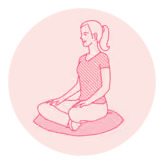Welcome to our comprehensive guide on Getting Started with Mindfulness. In today’s fast-paced world, stress and anxiety have become a common occurrence, and people are always looking for ways to alleviate these feelings. Mindfulness has emerged as a popular practice that has been proven to help reduce stress, anxiety, and depression. In this guide, we will take you through the basics of mindfulness, how it works, and how you can incorporate it into your daily life.
What is Mindfulness?
Mindfulness is a state of being present and fully engaged in the current moment. It involves paying attention to your thoughts, feelings, and physical sensations without judgment or distraction. Mindfulness is often associated with meditation, but it can also be practiced through various other activities, such as yoga, tai chi, or even walking.
The Benefits of Mindfulness
Research has shown that mindfulness can have a range of positive effects on both mental and physical health. Some of the benefits of mindfulness include:-
| Reduced Stress and Anxiety | Mindfulness has been found to reduce the symptoms of stress and anxiety, as well as improve overall emotional well-being. |
| Improved Focus and Concentration | By practicing mindfulness, you can increase your ability to focus and concentrate on the task at hand. |
| Increased Self-Awareness | Mindfulness can help you become more aware of your thoughts and emotions, which can lead to greater self-awareness and self-understanding. |
| Better Sleep | Mindfulness has been found to improve sleep quality, which can lead to improved overall health and well-being. https://mindfulgeneral.com/sleeping/ |
| Include whole grains | Whole grains are a great source of fiber, which helps keep you feeling full and satisfied throughout the morning. Try having whole-grain toast, oatmeal, or whole-grain cereal for a filling breakfast. |
| Add protein | Protein is essential for building and repairing muscles and helps keep you feeling full. Include protein-rich foods like eggs, Greek yogurt, or nuts in your breakfast. |
| Don’t forget fruits and vegetables | Fruits and vegetables are packed with vitamins, minerals, and antioxidants. Adding them to your breakfast can help boost your immune system and provide you with a variety of nutrients. Consider adding some fresh berries or sliced avocado to your breakfast. |
| Watch your portion sizes | While it’s important to include a variety of foods in your breakfast, it’s also essential to watch your portion sizes. Stick to the recommended serving sizes for each food group to avoid overeating. |
| Limit added sugars | Many breakfast foods, such as pastries and sweetened cereals, are high in added sugars. These can lead to energy crashes and spikes in blood sugar levels. Instead, opt for unsweetened or low-sugar options. |
How to Practice Mindfulness?
| Start Small | Begin by practicing mindfulness for a few minutes each day, and gradually increase the amount of time you spend practicing. |
| Focus on Your Breath | Pay attention to your breath as you inhale and exhale. Notice how your body feels as you breathe in and out. |
| Be Present | Allow yourself to fully immerse in the present moment, without worrying about the past or the future. |
| Non-Judgmental Awareness | Be aware of your thoughts and emotions, but don’t judge them. Simply observe them without any bias. |
| Incorporate Mindfulness into Your Daily Life | You can practice mindfulness while doing everyday activities, such as brushing your teeth, washing dishes, or even taking a shower. |
Incorporating Mindfulness into Your Daily Routine-
Mindfulness can help you become more playful, maximize your enjoyment of a long conversation with a friend over a cup of tea, then wind down for a relaxing night’s sleep. Try these 4 practices this week:-
| Mindful Eating | Take the time to savor your food, and pay attention to the flavors, textures, and smells.https://mindfulgeneral.com/web-stories/breakfast-receipe/ |
| Mindful Movement | Incorporate mindfulness into your exercise routine by paying attention to your body and breathing as you move. |
| Mindful Technology Use | Take breaks from technology and practice mindfulness while engaging in other activities, such as reading or spending time outdoors. |
| Mindful Communication | Practice active listening and being fully present during conversations with others. |
| Mindful Self-Care | Take time for self-care activities, such as meditation, yoga, or a relaxing bath. |


https://www.mindful.org/meditation/mindfulness-getting-started/


https://www.mindful.org/meditation/mindfulness-getting-started/
Mindfulness is a state of being present and fully engaged in the current moment.
Mindfulness has been proven to help reduce stress, anxiety, and depression by promoting self-awareness and a sense of calm in the present moment.
You can incorporate mindfulness into your daily life by practicing meditation, breathing techniques, and being mindful of your thoughts and actions in everyday activities.
Conclusion
Mindfulness is a powerful tool that can help you reduce stress, increase self-awareness, and improve overall well-being. By incorporating mindfulness into your daily routine, you can reap the benefits of this practice and live a happier, healthier life.
Can you be more specific about the content of your article? After reading it, I still have some doubts. Hope you can help me.
Can you be more specific about the content of your article? After reading it, I still have some doubts. Hope you can help me.
Thanks for sharing. I read many of your blog posts, cool, your blog is very good.
I’m really glad to hear that my article helped you feel hopeful!
I don’t think the title of your article matches the content lol. Just kidding, mainly because I had some doubts after reading the article.